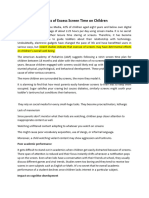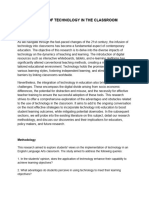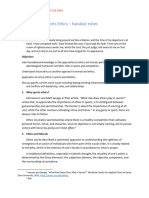Mohamed Arfaan Mohideen
English&101 Fall 2024
Proposing a Solution
12/4/2024
Gen Alpha and Screentime
In the modern world escaping from any form of screens is almost impossible. Phones,
tablets, TV’s and other technologies become a huge part of the early years of most modern
children’s lives. It can be argued that these devices make parenting easier and also might allow
for a more accessible form of learning for some children. However, the overreliance on screens
to parent children comes with several negative effects on the child themselves. They can develop
behavioral issues and find themselves with underdeveloped social skills. Along with this they can
also form many different physical as well as mental issues such as a reduced attention span as a
result of short form content plaguing the internet. The solution lies in forcefully limiting
screentime and promoting activities to children that don’t revolve around screens.
With firsthand experience, I’ve observed the negative effects that screens can have on
children with the siblings of my friends. When one of my friends’ younger siblings is sat down at
meal times, their first action is to pull out their phones and put a YouTube video on. When
spending hours on their devices, their social and emotional skills are impacted. They miss out on
important face to face interactions with their real-life family and friends. They lack lessons of
empathy, communication, problem solving and other values taken from their family.
� Another issue which stems from excessive screentime is the shortening of the attention
span. When the children are exposed to short form content such as what is found on YouTube
Shorts and TikTok, their minds are used to having content in a fast-paced manner and the ability
to simply swipe away when something is boring to them. This leads to them having difficulty in
a school environment where learning requires focus throughout a lesson which they can’t swipe
away from. They start to struggle with slower paced activities like doing homework, studying, or
even eating without a screen in front of them.
Finally, the physical aspect. When children spend all their time playing video games or
watching videos, they neglect the need to go outside and exercise, which can lead to obesity and
other weight related issues. Too much exposure to blue light from screens can also disrupt their
sleeping patterns which can affect their mood and health.
To fix these issues in their children, parents can take an approach using dead set rules
about screens. They should limit screen time to about 2 hours max. They can also designate
certain places in the house where screens cannot be used such as the dining table and bedrooms.
The remaining free hours of their day should be used to do something creative such as art,
building LEGOS, reading or physical activities such as playing outside with friends. While
screens shouldn’t be completely shut out, utilizing their screentime to show them informative
and educational content can be beneficial. Finally, parents themselves should see themselves as
role-models. Since children model after their elders, they should also limit screentime and make
sure their children see them doing productive things throughout the day to encourage them to
follow.
Since technology is basically unavoidable in today’s world, some argue that limiting
screentime simply wouldn’t work and that we need to adapt to the everchanging world. Its true
�that technology is essential today, children can learn to balance activities that don’t use screens
with one that do to make the most of the modern world while remaining on a healthy path.
Teaching kids how to use technology efficiently can help them learn skills from the world around
them while also taking advantage of the digital world.
In conclusion, excessive screentime in the youth today is an unavoidable issue which
poses several negative effects to them. Its impacts on their social lives, attention span and
physical health is enough for parents to be concerned. Limiting screentime and promoting
exercise and creative activities can ensure a healthy balance of screens and real life for the new
generation. Finding the balance between entertainment and learning is essential for the growth of
kids today.
























































































